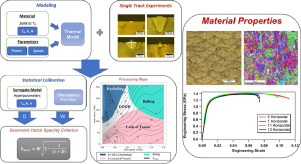当前位置:
X-MOL 学术
›
Acta Mater.
›
论文详情
Our official English website, www.x-mol.net, welcomes your
feedback! (Note: you will need to create a separate account there.)
An Ultra-High Strength Martensitic Steel Fabricated using Selective Laser Melting Additive Manufacturing: Densification, Microstructure, and Mechanical Properties
Acta Materialia ( IF 8.3 ) Pub Date : 2020-03-01 , DOI: 10.1016/j.actamat.2019.12.037 Raiyan Seede , David Shoukr , Bing Zhang , Austin Whitt , Sean Gibbons , Philip Flater , Alaa Elwany , Raymundo Arroyave , Ibrahim Karaman
Acta Materialia ( IF 8.3 ) Pub Date : 2020-03-01 , DOI: 10.1016/j.actamat.2019.12.037 Raiyan Seede , David Shoukr , Bing Zhang , Austin Whitt , Sean Gibbons , Philip Flater , Alaa Elwany , Raymundo Arroyave , Ibrahim Karaman

|
Abstract Martensitic steels have gained renewed interest recently for their use in automotive, aerospace, and defense applications due to their ultra-high yield strengths and reasonable ductility. A recently discovered low alloy martensitic steel, AF9628, has been shown to exhibit strengths greater than 1.5 GPa with more than 10% tensile ductility, due to the formation of e-carbide phase. In an effort to produce high strength parts with a high degree of control over geometry, the work herein presents the effects of selective laser melting (SLM) parameters on the microstructure and mechanical properties of this new steel. An optimization framework to determine the process parameters for building porosity-free parts is introduced. This framework utilizes the computationally inexpensive Eagar-Tsai model, calibrated with single track experiments, to predict the melt pool geometry. A geometric criterion for determining maximum allowable hatch spacing is also developed in order to avoid lack of fusion induced porosity in the as-printed parts. Using this framework, fully dense samples were successfully fabricated over a wide range of process parameters, allowing the construction of an SLM processing map for AF9628. The as-printed samples displayed tensile strengths of up to 1.4 GPa, the highest reported to date for any 3D printed alloy, with up to 11% elongation. The demonstrated flexibility in process parameter selection, while maintaining full density, opens up the possibility of local microstructural refinement and parameter optimization for improved mechanical properties in as-printed parts. The process optimization framework introduced here is expected to allow successful printing of new materials in an accelerated fashion.
中文翻译:

使用选择性激光熔化增材制造制造的超高强度马氏体钢:致密化、显微结构和机械性能
摘要 马氏体钢由于其超高的屈服强度和合理的延展性,最近因其在汽车、航空航天和国防应用中的应用而重新引起了人们的兴趣。最近发现的一种低合金马氏体钢 AF9628 由于形成了 e-碳化物相,已显示出大于 1.5 GPa 的强度和超过 10% 的拉伸延展性。为了生产高度控制几何形状的高强度零件,本文的工作介绍了选择性激光熔化 (SLM) 参数对这种新型钢的微观结构和机械性能的影响。介绍了一种确定用于构建无孔隙零件的工艺参数的优化框架。该框架利用计算成本低廉的 Eagar-Tsai 模型,通过单轨实验进行校准,预测熔池几何形状。还开发了用于确定最大允许舱口间距的几何标准,以避免在打印部件中缺乏融合引起的孔隙。使用该框架,在广泛的工艺参数范围内成功制造了完全致密的样品,从而为 AF9628 构建了 SLM 加工图。打印后的样品显示出高达 1.4 GPa 的拉伸强度,这是迄今为止任何 3D 打印合金的最高报道,伸长率高达 11%。在工艺参数选择方面表现出的灵活性,同时保持全密度,开辟了局部微观结构细化和参数优化的可能性,以改善印刷零件的机械性能。
更新日期:2020-03-01
中文翻译:

使用选择性激光熔化增材制造制造的超高强度马氏体钢:致密化、显微结构和机械性能
摘要 马氏体钢由于其超高的屈服强度和合理的延展性,最近因其在汽车、航空航天和国防应用中的应用而重新引起了人们的兴趣。最近发现的一种低合金马氏体钢 AF9628 由于形成了 e-碳化物相,已显示出大于 1.5 GPa 的强度和超过 10% 的拉伸延展性。为了生产高度控制几何形状的高强度零件,本文的工作介绍了选择性激光熔化 (SLM) 参数对这种新型钢的微观结构和机械性能的影响。介绍了一种确定用于构建无孔隙零件的工艺参数的优化框架。该框架利用计算成本低廉的 Eagar-Tsai 模型,通过单轨实验进行校准,预测熔池几何形状。还开发了用于确定最大允许舱口间距的几何标准,以避免在打印部件中缺乏融合引起的孔隙。使用该框架,在广泛的工艺参数范围内成功制造了完全致密的样品,从而为 AF9628 构建了 SLM 加工图。打印后的样品显示出高达 1.4 GPa 的拉伸强度,这是迄今为止任何 3D 打印合金的最高报道,伸长率高达 11%。在工艺参数选择方面表现出的灵活性,同时保持全密度,开辟了局部微观结构细化和参数优化的可能性,以改善印刷零件的机械性能。











































 京公网安备 11010802027423号
京公网安备 11010802027423号